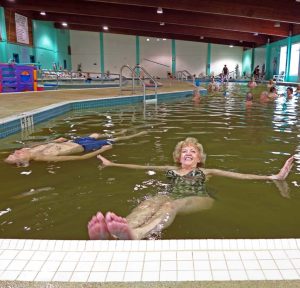By Jane Cassie
 What’s one thing that most people hope for when planning a vacation? Good weather, right? It’s always top priority on my travel wish list. So, as we load onto the BC ferry, bound for Langdale, my spirits literally dampen when pellet-size droplets spill from the swollen skies. “Maybe the Sunshine Coast will live up to its name,” my optimistically-minded husband says, from beneath his protective umbrella. “I’ve heard the odds are pretty good.”
What’s one thing that most people hope for when planning a vacation? Good weather, right? It’s always top priority on my travel wish list. So, as we load onto the BC ferry, bound for Langdale, my spirits literally dampen when pellet-size droplets spill from the swollen skies. “Maybe the Sunshine Coast will live up to its name,” my optimistically-minded husband says, from beneath his protective umbrella. “I’ve heard the odds are pretty good.”
He’s absolutely right. It’s reported that this lush 180 kilometer (110 mi) strip of shoreline, sandwiched between Pacific waves and coastal peaks, receives around 2,400 hours of annual sun. Though it’s a little premature to dig out the sun block, my fingers are crossed.
Our island-studded cruise of Howe Sound is scenic and smooth, and by the time we bridge the forty minute waterway my weather wish comes true. A few meager rays break through the thick grey dome above and brighten the adventuresome route that waits ahead.
While some veer into the seaside town of Gibsons, and home of Molly’s Reach, we take the high road. Gnarled arbutus trees and bushy evergreens frame our peek-a-boo ocean views where kayakers, canoeists and sailors ply protected waterways. Land lovers are lured to the Mother lode of ‘grounded’ adventures; nature walks, hiking trails, picnic pull-ins and campgrounds –everything from rustic backwoods sites to lush parks that are packed with amenities.
We coast through the laid-back community of Robert’s Creek, parallel the promenade that rims Davis Bay and tootle along Sechelt’s main drag. This thriving hub that’s well rooted by Coast Salish heritage is linked by a slender isthmus to BC’s mainland. An inland sea, gouged out by the melting ice age 10,000 years ago, fills the gap in between. Today, this tranquil waterway is rated one of the top 100 dive sites in the world, and the sunken HMCS Chaudiere provides a flourishing reef.
Situated at the southern end of this idyllic inlet is Porpoise Bay Provincial Park, just one of the pleasure stops that dot the shoreline. Tall timbers shade the grassy areas and a sandy beachfront skirts the bay. As well being a drawing card for families, kayakers take to these still waters, floatplanes view them from above, and anchored yachts bob here in regal style.
Although it all looks inviting, we keep on trekking –along Halfmoon Bay, beyond the alluring picnic grounds of Coopers Green Regional Park and past the hidden gem of Secret Cove.
Finally we meander into Pender Harbour, a waterfront enclave that collectively unites the communities of Madeira Park, Garden Bay and Irving’s Landing. Inlets are sculpted into the lush shoreline, lakes are carved into the wooded hillsides and islets dot the aquatic perimeters. It’s not surprising that this stunning seascape has been coined ‘Venice of the North.’ We also discover that it’s one epic playground!
Before expending any energy, we re-fuel at the Copper Sky Café and Gallery, a funky eatery that combines home cooking with artisan treasures. With mile-high sandwiches and scrumptious pastry under our belt, we’re ready for action and Andy Cardiff, owner of Malaspina Water Taxi has plenty of it to dish out. He’s been the skipper of his ocean going cruisers and kayaks since 2005 and it’s easy to see he’s in his glory. “I operate year-round, 24/ 7,” he says with a wide grin. “And to me, this kind of work is playtime.”
We could paddle to the untarnished jewel of Jedediah Island where hiking trails weave through old-growth Douglas Fir or cruise to the distant Chatterbox Falls that tumbles from a forty-five meter precipice. But there’s no need to stray that far. The surrounding region not only offers unspoiled beauty but brims over with natural wonders.
With Andy at the helm, we cruise out of the harbor, passing classy hilltop homes and the hiker’s hangout of Mount Daniel. We check out the craggy Indian Islands where eagles, herons and teary-eyed seals provide non-stop entertainment and sidle up to Fearney Bluffs, a 120 meter (400 ft) deep grotto that thrives with sea life. Pictographs etched on granite rock faces depict an ancient story and Agamemnon Channel frames the omnipresent snow tipped peaks. Our final stop is Robert’s Beach on Nelson Island where remnants of an old log cabin still stand. Embracing the setting is crescent-shaped shoreline that’s strewn with storm-tossed driftwood. As well as a hot spot to explore it’s a perfect place to reflect and relax. And like the rest of this two hour tour, leaves us with a sense of awe.
We both love the great outdoors and though the Sunshine Coast is dotted with places to pitch a tent, when it comes to doing the ‘camp thing’ my husband and I don’t quite jive. He’d be quite content to cuddle in a mummy bag of eiderdown, but my spine goes into spasm after sleeping on a mattress of earthy rough stuff. Thanks to our posh eco-style accommodations along the way, more on my wish list is granted.
 Even though it’s just minutes from the grid, Sakinaw Lake Lodge feels blissfully removed from civilization. We’re whisked away by an African Queen-like pontoon boat to the far side of the lake where it snuggles into the forested hillside. Two of the guest sanctuaries cantilever over lapping waves. The main cozy cottage that sleeps three, boasts an all-equipped kitchen and the penthouse tent house depicts glamping to a tee. Chiropractic queen beds, crisp Egyptian cotton duvets, comfy Fretted bathrobes –this is my kind of camping!
Even though it’s just minutes from the grid, Sakinaw Lake Lodge feels blissfully removed from civilization. We’re whisked away by an African Queen-like pontoon boat to the far side of the lake where it snuggles into the forested hillside. Two of the guest sanctuaries cantilever over lapping waves. The main cozy cottage that sleeps three, boasts an all-equipped kitchen and the penthouse tent house depicts glamping to a tee. Chiropractic queen beds, crisp Egyptian cotton duvets, comfy Fretted bathrobes –this is my kind of camping!
 The property is a labor of love for Garrett and Liza Gabriel, and Garrett’s mother, Donna. “We each have our preferences and talents,” Liza shares. “Donna has the green gardener’s thumb, Garret is the wine guy and I do most of the cooking.”
The property is a labor of love for Garrett and Liza Gabriel, and Garrett’s mother, Donna. “We each have our preferences and talents,” Liza shares. “Donna has the green gardener’s thumb, Garret is the wine guy and I do most of the cooking.”
Bountiful breakfasts are included with each night’s stay and though a communal barbecue, fridge and cooking facilities are available for other meals, guests often opt for the delicious delights ala Liza. It’s hard to turn down her miso-glazed halibut, wasabi mashed potatoes and roasted asparagus, especially when paired with Garret’s recommended vino. Yes, it sure beats baked beans around the campfire!
And this hideaway also offers lots of ways to help burn off those unwanted calories. Balance on a wakeboard, skim the lake on a boat cruise, trek the trails that lace its seven wooded acres –or feel free to follow our lead. Just sit back and relax in the shadow of Hallowell Mountain and enjoy this slice of serenity.
In addition to seclusion, our next eco retreat, literally offers a taste of Desolation.
 Jervis Inlet bisects the upper and lower sections of the Sunshine Coast and BC Ferries bridges them together. Our fifty minute scenic cruise is more like a National Geographic slide show and from front row seats the rolling vistas include quiet inlets, lush finger-like fjords and jagged peaks.
Jervis Inlet bisects the upper and lower sections of the Sunshine Coast and BC Ferries bridges them together. Our fifty minute scenic cruise is more like a National Geographic slide show and from front row seats the rolling vistas include quiet inlets, lush finger-like fjords and jagged peaks.
From the ferry drop off point at the divers den of Saltery Bay, Highway 101 continues to pave the way. We pass by a strip of verdant parkland that links the hub of Westview with Powell River’s historic Townsite, bisect the recreation jewel of Powell Lake and slink by the Coast Salish village of Sliammon. It’s tempting to stop and survey each scene, but we’re on a mission for more creature comforts. And we soon find them at the end of the road.
 The quaint historical fishing village of Lund, founded by the Thulin brothers in 1889, is also the gateway to Desolation Sound. Along with remnants of the Swedish heritage it oozes lots of charm and allure. A boardwalk flanked by a handful of shops and eateries trails down to the hull-filled marina. Whether it’s waiting for the fresh catch to come in or a tour boat to go out, there’s never a dull moment.
The quaint historical fishing village of Lund, founded by the Thulin brothers in 1889, is also the gateway to Desolation Sound. Along with remnants of the Swedish heritage it oozes lots of charm and allure. A boardwalk flanked by a handful of shops and eateries trails down to the hull-filled marina. Whether it’s waiting for the fresh catch to come in or a tour boat to go out, there’s never a dull moment.
Overlooking this waterfront town from its solo rocky bluff is The Sevilla Island Resort, a posh spot that combines pampering perks with treats from the sea. Owners Ian Hobbs and Donna Kaye roll out the red carpet and in the comfort of their cruiser we’re transported to this dream scene. The thirty five hundred square foot treasure delightfully unites flavours of the West Coast with Santa Fe. Gleaming hemlock floors lead us to our handsomely decorated suite, where a colourful duvet drapes the comfy queen bed and flat screen TV provides late night viewing. Thirsty towels and heat lamps warm up the spa style bathroom, and our private deck offers an awesome sea view. The same vista is framed by the twenty four foot high windows of the main floor great room, a faux finished beauty where we can read, relax, watch TV or listen to music.
 In the adjacent dining room mealtime magic happens three times a day. Our palates are pleased after the chef savvy line-up; beautifully executed crab cakes precede Sevilla Island Seafood Boats, Ian’s sensational creation of roasted squash that brims over with scallops, salmon, and prawns. After being paired with fine wine it’s topped off with a decadent dessert. We also discover that the breakfasts are just as grand: melt in your mouth blueberry scones and homemade preserves, followed by hearty entrees –ranging from anything and everything omelets to fluffy French toast. Ian and Donna believe a hearty meal is an important start to the day. And in order to check out the abundant sea life that thrives below the lapping waves, you’ll want to be energized.
In the adjacent dining room mealtime magic happens three times a day. Our palates are pleased after the chef savvy line-up; beautifully executed crab cakes precede Sevilla Island Seafood Boats, Ian’s sensational creation of roasted squash that brims over with scallops, salmon, and prawns. After being paired with fine wine it’s topped off with a decadent dessert. We also discover that the breakfasts are just as grand: melt in your mouth blueberry scones and homemade preserves, followed by hearty entrees –ranging from anything and everything omelets to fluffy French toast. Ian and Donna believe a hearty meal is an important start to the day. And in order to check out the abundant sea life that thrives below the lapping waves, you’ll want to be energized.
“I’ve been diving all over the world,” Ian shares, “And the underwater metropolis in this area beats anything I’ve ever seen.” Whether it’s from behind a snorkel and mask or in the comfort of his ocean-worthy cruiser, Ian promises to make your every eco wish come true. Kayak the neighboring islands where you’ll spot seals, eagles, and sea stars. Bike on Savary Island and picnic on a sandy beach, or hike the Sunshine Coast Trail that stretches all the way to Saltery Bay.
 Lund’s Terracentric Coastal Adventures also provides tours above and beneath the deep, and on our final day we venture out on a zodiac, with high hopes of spotting some sea life. The sky looks ominous and dark bulbous clouds threaten rain. Once again my fingers are crossed for a little bit of luck.
Lund’s Terracentric Coastal Adventures also provides tours above and beneath the deep, and on our final day we venture out on a zodiac, with high hopes of spotting some sea life. The sky looks ominous and dark bulbous clouds threaten rain. Once again my fingers are crossed for a little bit of luck.
We cruise up Thulin passage, a slim waterway that separates the mainland from the Copeland Islands and slow down to take photos of stoic cormorants, blue herons and a family of mergansers. Birdlife is prolific in these parts, as is the beauty. Kingfishers, sandpipers, gulls and other migratory species are spotted around the craggy shorelines, evergreen islets and older growth timber. We agree whole-heartedly with Jacques Cousteau that the scenery is second to none.
 Terracentric believes that we’re all connected to our natural environment and our guide Christine Hollmann has a wonderful way of integrating eco-education with the stunning surroundings. While paralleling the mainland, we learn about the First Nations people and explorer Captain Vancouver. In shallow bays she shares the symbiotic relationship between otters, sea urchins and kelp. And when checking out lazy sun-bathing seals we discover the importance of keeping our distance. This act of privacy is a guideline that Christine closely adheres to and though we never invade their personal space, we’re able to get a real good glimpse of the sea life that abounds.
Terracentric believes that we’re all connected to our natural environment and our guide Christine Hollmann has a wonderful way of integrating eco-education with the stunning surroundings. While paralleling the mainland, we learn about the First Nations people and explorer Captain Vancouver. In shallow bays she shares the symbiotic relationship between otters, sea urchins and kelp. And when checking out lazy sun-bathing seals we discover the importance of keeping our distance. This act of privacy is a guideline that Christine closely adheres to and though we never invade their personal space, we’re able to get a real good glimpse of the sea life that abounds.
 As we’re heading back, we have one last performance –a grand finale off to the distant starboard. Jet black torsos break the still surface, revealing their pure white undercarriages before submerging again. They swim at record speeds, darting back and forth, leaping and cresting in unison, creating a riot of rooster tail spray. Though it’s just a feeding frenzy to these Dall’s Porpoise, it’s a synchronized water ballet to us. And as rays of sun slice through the cloudy overcast sky, another wish is granted. The Sunshine Coast –it’s a destination of eco excellence whatever the weather!
As we’re heading back, we have one last performance –a grand finale off to the distant starboard. Jet black torsos break the still surface, revealing their pure white undercarriages before submerging again. They swim at record speeds, darting back and forth, leaping and cresting in unison, creating a riot of rooster tail spray. Though it’s just a feeding frenzy to these Dall’s Porpoise, it’s a synchronized water ballet to us. And as rays of sun slice through the cloudy overcast sky, another wish is granted. The Sunshine Coast –it’s a destination of eco excellence whatever the weather!
If You Go:
Copper Sky Café and Gallery
12904 Madeira Park Road
Madeira Park, BC
Tel: (604) 883-0096 Gallery (604) 883-0098
Email: copperskygallery@dccnet.com
Malaspina Water Taxi & Tours
Tel: 604-989-BOAT (2628)
Email MalaspinaWaterTaxi@gmail.com
Sakinaw Lake Lodge
Tel: 1-604-989-3242 (888) 341-1720
Email: escape@sakinawlakelodge.com
Sevilla Island Resort
Tel: 604-414-6880
Email: info@sevillaislandresort.ca
Terracentric Coastal adventures ltd.
Tel: (604) 483 7900
info@terracentricadventures.com
Sunshine Coast
www.bigpacific.com/
This week Traveling Tales welcomes the freelance travel writer/photographer team of Jane and Brent Cassie, who live in South Surrey, a suburb of Vancouver B.C..
Photos by Brent Cassie:
1. Roberts Beach
2. Saknaw Lake Lodge
3. Owners of the Lodge
4. Fjords of Jervis Inlet
5. Lund
6. Ian Host & Chef
7. Zodiac in bay
8. Seals on rocks
9. Comorants
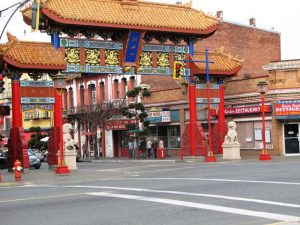
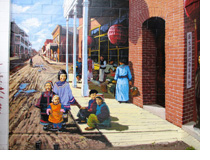 This is also a story of humiliation. A dark time in our history when racism flourished like a parasitic flower watered by discrimination and injustice. In an effort to discourage Chinese from coming to these shores, a head tax of $50 was applied (an enormous sum in those days), and when that failed to have the desired effect, it was increased to $500. It meant that many men weren’t able to afford to bring their wives and children to Canada, and spent whatever leisure time they had hanging out in bars and gambling dens, their loneliness tempered only by the oblivion of the opium pipe, and the consolation of prostitutes. They worked hard, but the lure of easy money on the gambling circuit meant that they often lost hard too.
This is also a story of humiliation. A dark time in our history when racism flourished like a parasitic flower watered by discrimination and injustice. In an effort to discourage Chinese from coming to these shores, a head tax of $50 was applied (an enormous sum in those days), and when that failed to have the desired effect, it was increased to $500. It meant that many men weren’t able to afford to bring their wives and children to Canada, and spent whatever leisure time they had hanging out in bars and gambling dens, their loneliness tempered only by the oblivion of the opium pipe, and the consolation of prostitutes. They worked hard, but the lure of easy money on the gambling circuit meant that they often lost hard too.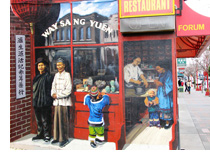 On Fisgard, Adams pauses before mural of this very same street, back in the 1880s. It portrays a squelchy mud road, flanked by houses with wooden balconies, and the artist has prettied it up by including kids and women – none of whom, according to Adams would have been there at the time. The adjoining mural depicting Way Sang Yuen’s herbalist shop is no longer there (it’s now in the Burnaby Village Museum) but today’s Chinatown still boasts herbalists galore. I drop into one just a few steps away, and am engulfed by a completely
On Fisgard, Adams pauses before mural of this very same street, back in the 1880s. It portrays a squelchy mud road, flanked by houses with wooden balconies, and the artist has prettied it up by including kids and women – none of whom, according to Adams would have been there at the time. The adjoining mural depicting Way Sang Yuen’s herbalist shop is no longer there (it’s now in the Burnaby Village Museum) but today’s Chinatown still boasts herbalists galore. I drop into one just a few steps away, and am engulfed by a completely 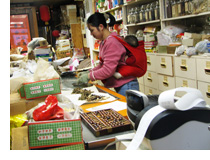 different world. The room is cramped, the glass display case filled with gnarled roots, twigs, seeds and other esoteric medicinal potions, labeled in Chinese. The herbalist doctor has a line up of people to meet with him, so I content myself with watching his assistant weigh several bundles of leaves and pound them in a mortar and pestle. She speaks no English, but smiles broadly. Her little girl offers me her kitten to stroke.
different world. The room is cramped, the glass display case filled with gnarled roots, twigs, seeds and other esoteric medicinal potions, labeled in Chinese. The herbalist doctor has a line up of people to meet with him, so I content myself with watching his assistant weigh several bundles of leaves and pound them in a mortar and pestle. She speaks no English, but smiles broadly. Her little girl offers me her kitten to stroke.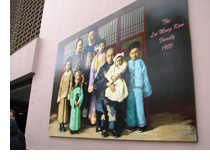 Probably the most illustrious “Lee” in Chinatown is featured on a mural directly opposite the Chinese Public School. Lee Mong Kow was a dynamic business entrepreneur, a dedicated champion of his Chinese brethren (he acted as a go-between between the Chinese and Canadian bureaucracy) and a tireless social worker. He somehow also managed to find time (and energy!) to sire seventeen children, thirteen of whom survived to adulthood.
Probably the most illustrious “Lee” in Chinatown is featured on a mural directly opposite the Chinese Public School. Lee Mong Kow was a dynamic business entrepreneur, a dedicated champion of his Chinese brethren (he acted as a go-between between the Chinese and Canadian bureaucracy) and a tireless social worker. He somehow also managed to find time (and energy!) to sire seventeen children, thirteen of whom survived to adulthood.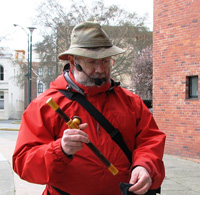 Adams takes us via Lee Mong Kow Way to Centennial Square once part of Cormorant Street, the very centre of old Chinatown. A few high class brothels flanked the street as did an opium factory. Opium was legal then; gambling however was not!
Adams takes us via Lee Mong Kow Way to Centennial Square once part of Cormorant Street, the very centre of old Chinatown. A few high class brothels flanked the street as did an opium factory. Opium was legal then; gambling however was not!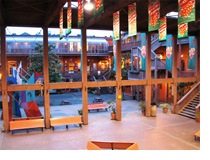 burned (along with joss sticks) at funerals to ensure that the spirits of the departed are comfortable and have money to spend in the afterlife. This is a prelude to the most fascinating of all subjects on this tour—the traditions and rites which shaped Chinese lives, not just then, but also today. Adams is a superb raconteur, and his perceptive insights shed light on Eastern beliefs that stand in contrast to our pragmatic Western outlook.
burned (along with joss sticks) at funerals to ensure that the spirits of the departed are comfortable and have money to spend in the afterlife. This is a prelude to the most fascinating of all subjects on this tour—the traditions and rites which shaped Chinese lives, not just then, but also today. Adams is a superb raconteur, and his perceptive insights shed light on Eastern beliefs that stand in contrast to our pragmatic Western outlook.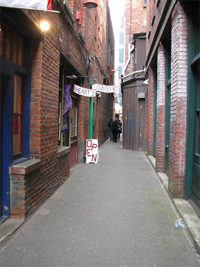 A highlight of the tour is Fan Tan Alley, a narrow lane running like a crack between red two-storey brick buildings. Despite the souvenir shops and trendy clothing racks lining the alleyway, there is much that evokes a sense of the past—secret gambling and opium dens that flourished above the alley and its maze of tributary lanes. Chinese signage mark entrances to hidden courtyards such as the one where Adams gives us a quick demonstration of how to play Fan Tan, the popular gambling pastime from which the alleyway derives its name. A red wooden door carrying the number 23 ½ denotes a mezzanine residential apartment tucked in between floors—at one time it probably housed several men rooming together to save money. Like Fan Tan Alley, Dragon Alley on the north side of Fisgard street, was also a secluded labyrinthine neighbourhood.
A highlight of the tour is Fan Tan Alley, a narrow lane running like a crack between red two-storey brick buildings. Despite the souvenir shops and trendy clothing racks lining the alleyway, there is much that evokes a sense of the past—secret gambling and opium dens that flourished above the alley and its maze of tributary lanes. Chinese signage mark entrances to hidden courtyards such as the one where Adams gives us a quick demonstration of how to play Fan Tan, the popular gambling pastime from which the alleyway derives its name. A red wooden door carrying the number 23 ½ denotes a mezzanine residential apartment tucked in between floors—at one time it probably housed several men rooming together to save money. Like Fan Tan Alley, Dragon Alley on the north side of Fisgard street, was also a secluded labyrinthine neighbourhood.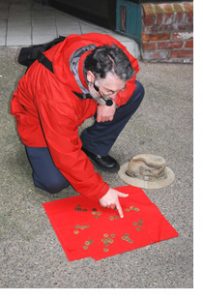 Although the Chinatown Walking tour with John Adams ends at the Gate of Harmonious Interest, he offers to accompany those of us who are interested in taking a look at the oldest Chinese temple in Chinatown. Housed in the topmost floor of the Yen Wo Society building across the street, the Tam Kung temple is worth the climb of 51 steps.
Although the Chinatown Walking tour with John Adams ends at the Gate of Harmonious Interest, he offers to accompany those of us who are interested in taking a look at the oldest Chinese temple in Chinatown. Housed in the topmost floor of the Yen Wo Society building across the street, the Tam Kung temple is worth the climb of 51 steps.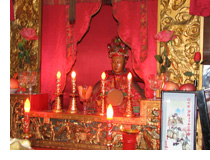 A patron saint of seafarers, Tam Kung’s statue is resplendent in red and gold brocade robes, set within an elaborate gilt framework which glows in the light of candles. Ornate silk processional flags and banners cover the walls, and the altar is laden offerings of fruit and flowers. Few devotees are here this morning, and the temple is tranquil, the only sound being the muffled ‘whoosh’ of traffic wafting up from Government Street. Adams talks about Eastern beliefs in predestined fate, and the search for answers to questions, obtained by tossing small wooden tokens, or the process of vigorously shaking bamboo sticks in a container, to reveal coded messages predicting health and prosperity, or the lack of it.
A patron saint of seafarers, Tam Kung’s statue is resplendent in red and gold brocade robes, set within an elaborate gilt framework which glows in the light of candles. Ornate silk processional flags and banners cover the walls, and the altar is laden offerings of fruit and flowers. Few devotees are here this morning, and the temple is tranquil, the only sound being the muffled ‘whoosh’ of traffic wafting up from Government Street. Adams talks about Eastern beliefs in predestined fate, and the search for answers to questions, obtained by tossing small wooden tokens, or the process of vigorously shaking bamboo sticks in a container, to reveal coded messages predicting health and prosperity, or the lack of it.
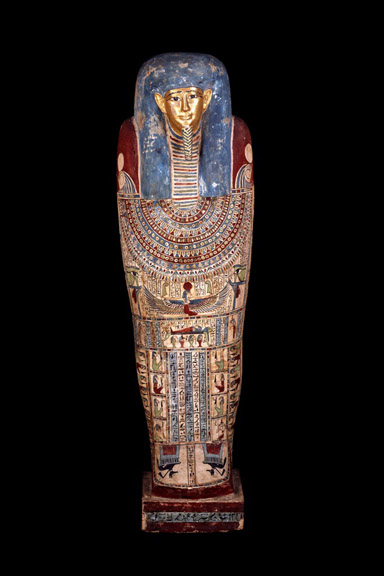
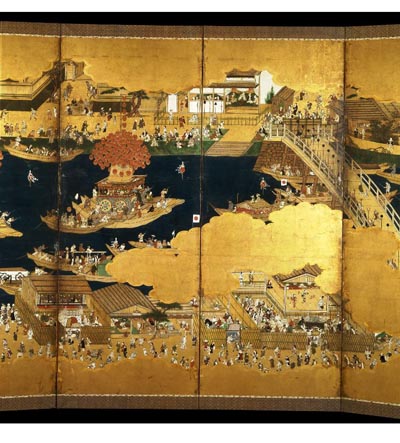

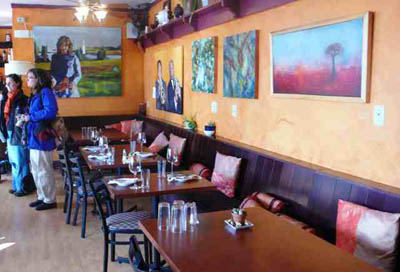
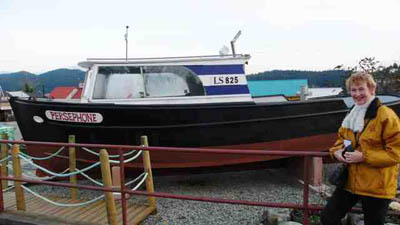
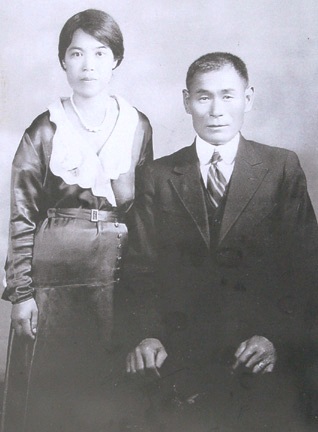
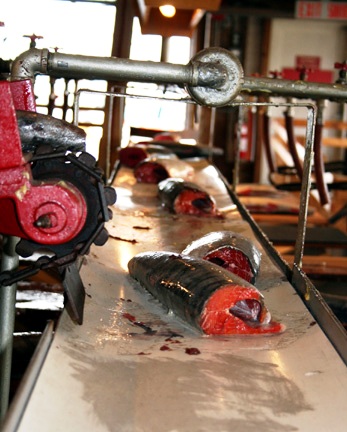














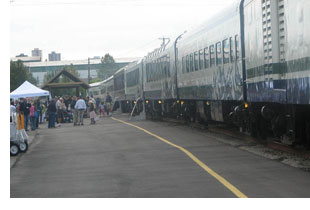 Two things never cease to delight me: firstly, the splendour of our British Columbia scenery, and secondly, the exhilaration of train travel. Today, I’m about to enjoy both on a journey aboard the Whistler Mountaineer.It is a surprisingly chilly and pale July morning, but that does nothing to dampen the anticipation of the crowd gathered at the railway station in North Vancouver. Kids jump up and down gleefully, and parents and grandparents help themselves to complimentary coffee while awaiting the “All Aboard” call.
Two things never cease to delight me: firstly, the splendour of our British Columbia scenery, and secondly, the exhilaration of train travel. Today, I’m about to enjoy both on a journey aboard the Whistler Mountaineer.It is a surprisingly chilly and pale July morning, but that does nothing to dampen the anticipation of the crowd gathered at the railway station in North Vancouver. Kids jump up and down gleefully, and parents and grandparents help themselves to complimentary coffee while awaiting the “All Aboard” call.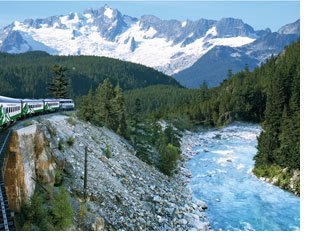 And then comes the big “Aaaah!” of the journey—the spectacular Cheakamus Canyon. For travellers on the Whistler Mountaineer, this sight alone is worth the price of admission. We run along its lip, as the river boils and foams, far, far below us, forcing its way through narrow channels and erupting around bends.
And then comes the big “Aaaah!” of the journey—the spectacular Cheakamus Canyon. For travellers on the Whistler Mountaineer, this sight alone is worth the price of admission. We run along its lip, as the river boils and foams, far, far below us, forcing its way through narrow channels and erupting around bends.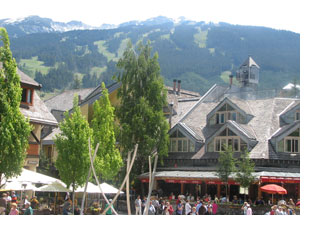 At Whistler, the chill of the morning has given way to brilliant sunshine and the village is filled with holiday crowds: teens on bikes, young couples hand in hand, and families with toddlers in tow.
At Whistler, the chill of the morning has given way to brilliant sunshine and the village is filled with holiday crowds: teens on bikes, young couples hand in hand, and families with toddlers in tow. The tangerine sun begins its daily departure. To our left looms a thick backdrop of old growth evergreens. To our right, clear waves tumble at our feet. Dusk settles over smooth charcoal coloured sand as we walk, hands clutched, we’re awed by the breathtaking view. Tofino. It’s no ordinary place.
The tangerine sun begins its daily departure. To our left looms a thick backdrop of old growth evergreens. To our right, clear waves tumble at our feet. Dusk settles over smooth charcoal coloured sand as we walk, hands clutched, we’re awed by the breathtaking view. Tofino. It’s no ordinary place.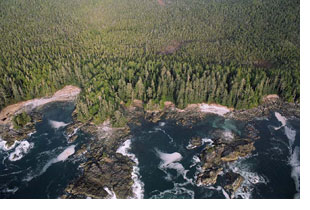 Hot Springs Cove is so captivating we almost miss our flight, and although jelly-legged and breathless after the race back, we make it just in time for our Tofino Air take off.
Hot Springs Cove is so captivating we almost miss our flight, and although jelly-legged and breathless after the race back, we make it just in time for our Tofino Air take off.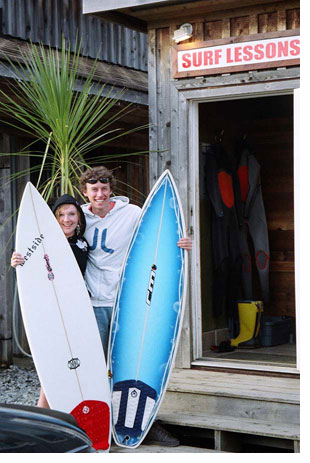 “Good morning,” Cal whispers, as we wake for our final and most exhilarating day. Surfing is unlike any sport. Step foot in the Pacific and you’ll understand. White water swirls around our raven rubber ankles as we watch the wild untamed swell.
“Good morning,” Cal whispers, as we wake for our final and most exhilarating day. Surfing is unlike any sport. Step foot in the Pacific and you’ll understand. White water swirls around our raven rubber ankles as we watch the wild untamed swell. 